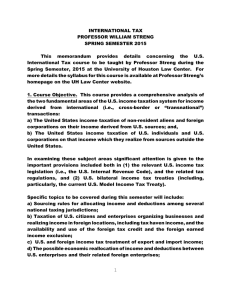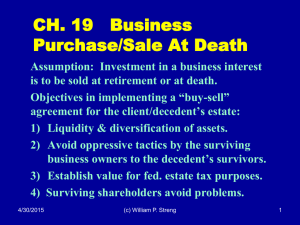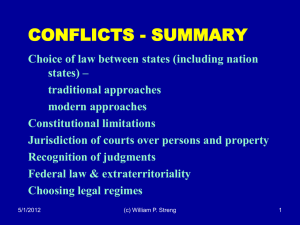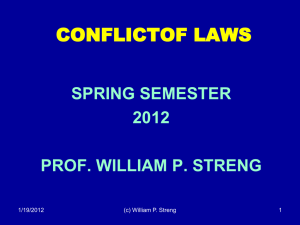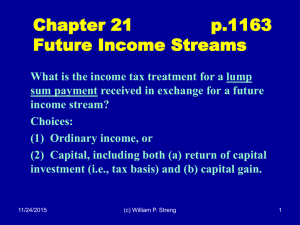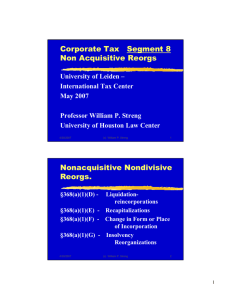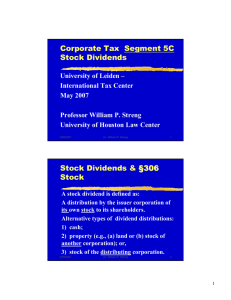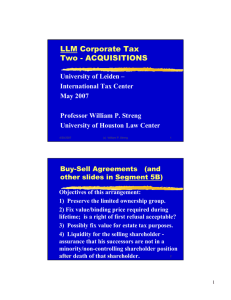Corporate Taxation
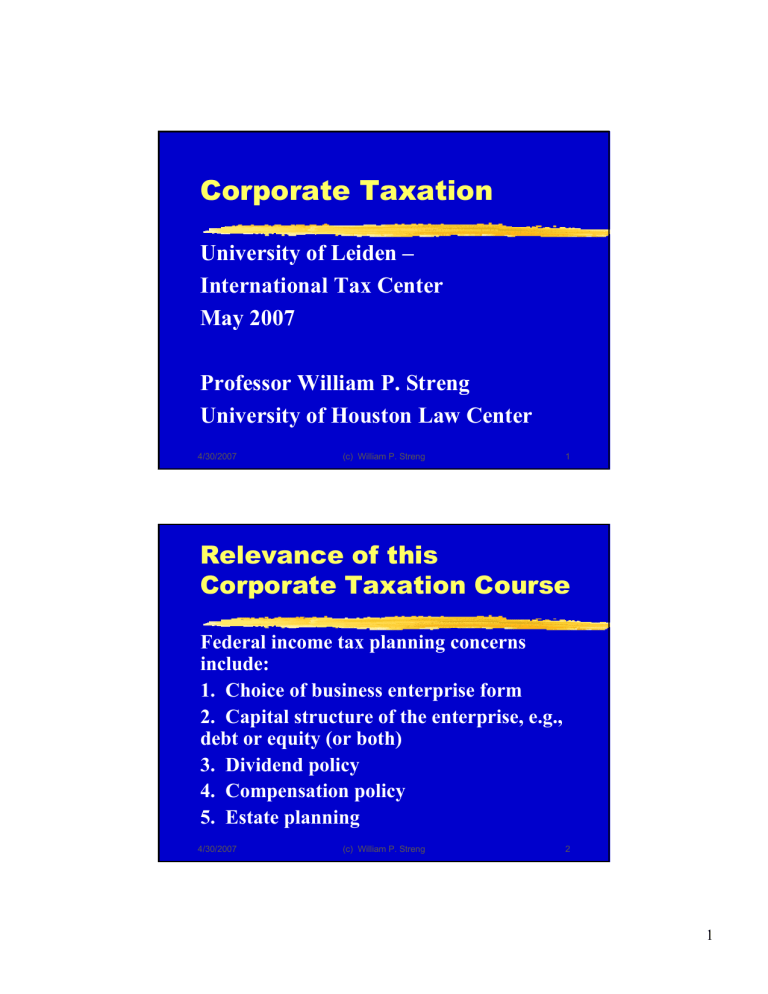
Corporate Taxation
University of Leiden –
International Tax Center
May 2007
Professor William P. Streng
University of Houston Law Center
4/30/2007 (c) William P. Streng 1
Relevance of this
Corporate Taxation Course
Federal income tax planning concerns include:
1. Choice of business enterprise form
2. Capital structure of the enterprise, e.g., debt or equity (or both)
3. Dividend policy
4. Compensation policy
5. Estate planning
4/30/2007 (c) William P. Streng 2
1
BUSINESS ENTITY
CHOICES
Corporation
“C” or “S” corporate tax status
Partnership - General or limited
Limited Liability Company (LLC)
Trust or Estate (available?)
Sole Proprietorship
Disregarded Entity (DRE)
4/30/2007 (c) William P. Streng 3
Corporation/Shareholder
Tax Policy Issues
1) Double taxation, i.e., at corporate and shareholder level; but, 2003 Act.
2) Tax rates on ordinary income corporation and shareholder;
Equalized after the 2003 Act?
3) Preferential capital gains rates.
4) Non-recognition upon asset/ownership shifts.
4/30/2007 (c) William P. Streng 4
2
Fundamental Corporate
Tax Technical Issues
1. Contributions to the corporation - gain recognition to either party?
2. Arrangements between owners & entity – i.e., "assignment of income” permitted?
3. Distributions of appreciated property.
4. Corporate liquidations, including sales in conjunction with a corporate liquidation.
5. Corporate reorganizations - possible
4/30/2007 postponement of gain recognition.
5
“Cradle to Grave” Approach in this Course
1.
What is a “corporation”?
2.
Organization - §351 Note: Code § 61.
3.
Tax on corporate income?
Entity level tax or flow-through?
4.
Capital structure - Debt vs. equity
Is interest expense deduction available?
Tax-free repatriation of debt?
5.
Dividends – tax treatment? continued
3
“Cradle to Grave”, cont.
6.
Significant interim distributions:
Redemptions & partial liquidations
Stock dividends
§306 stock (indirect dividend?)
7.
Terminating stock ownership interest
8.
Taxable complete or partial liquidation
9.
Corporate tax-free reorganizations
4/30/2007 (c) William P. Streng 7
Concepts of “Tax Common
Law”
Non-codified federal income tax rules
(particularly relevant in the corporate income tax context):
1) The “sham transaction” rule.
2) “Substance over form” analysis.
3) The “business purpose” doctrine.
4) The “step transaction” doctrine.
4/30/2007 (c) William P. Streng 8
4
Federal Income Taxation of the Corporation
1) Code §11- graduated tax rate structure.
- Code §11(b)(1) - no lower initial brackets for personal service companies.
2) Determination of the corporation’s taxable income – no “above the line” vs. “below the line”;
- dividends received deduction is available.
- Deduction for domestic production - §199.
3) Accounting period – is the calendar year required?
4) Accrual method of accounting? §448(a).
4/30/2007 (c) William P. Streng 9
Income Taxation of the
Corporation, cont.
5) Code §267 – limitations on transactions between corp. & owners, i.e., potential “gaps.”
6) Corporate Alternative Minimum Tax repealed for small corporations.
7) Multiple corporations - § 1561
Consolidated tax returns for an affiliated group of corporations - §§ 1501-1504.
8) The “S” corporation alternative.
4/30/2007 (c) William P. Streng 10
5
Example
(a) Determining corporate level gross income:
Inventory sales 2,500,000
Dividends
Capital gains
100,000
200,000
2,800,000
Exclusion under §103 for muni-bond interest continued
4/30/2007 (c) William P. Streng 11
Deductions Against GI
Operating expenses
Depreciation
600,000
800,000
Passive leasing activity loss 130,000
§469(a)(2)(B) & §469(e)(2)
Capital loss (limit to gain)
4/30/2007
200,000
Dividends received deduction 70,000
Total deductions 1,800,000
(c) William P. Streng continued
12
6
Determining Tax Liability
§11(b)(1) tax calculation on $1 million taxable income:
15% of 50,000 7,500
25% of 25,000
34% of 925,000
Plus: lesser of $45,000
6,250
314,500
(5% of 900,000) or 11,750 11,750
340,000
4/30/2007 (c) William P. Streng 13
Dividend distribution
Distribution of $660,000 after-tax profit
§61(a)(7) dividend income
20 percent of $660,000 = $132,000
Total taxes: (340 + 132) $472,000
Amount for shareholders: $528,000
Effective tax rate: 47.2 percent
(is a 47.2% effective tax rate too much?)
4/30/2007 (c) William P. Streng 14
7
Deductible (?) payments
1) $500,000 salaries paid - to eliminate all corporate level income.
Reasonable compensation?
2) Other corporate level deductions available for this purpose?
§79 - group term insurance
4/30/2007
§105 & 106 - health benefits
(c) William P. Streng 15
Corporate Tax Shelters
Concept of “tax sheltering”- claiming tax losses without economic losses, including questionable economic substance.
Possible use of “tax indifferent” parties.
Aggressive marketing, coupled with secrecy.
Tax opinions which are aggressive.
Playing the “audit lottery”.
Note applicability of “Circular 230.”
4/30/2007 (c) William P. Streng 16
8
Attempts to Limit
Corporate Tax Shelters
1) IRS litigation strategy.
2) Disclosure of tax shelter investments, including registration of tax shelters.
3) Increased “substantial understatement” penalty.
4) Excise tax on promoter’s fees.
5) Enhanced requirements on conduct of professionals. Treas. Circular 230.
4/30/2007 (c) William P. Streng 17
UPS case
UPS organized an offshore subsidiary (OPL) to provide reinsurance for excess value insurance on shipments.
OPL shares distributed to UPS shareholders.
Issue re income for excess value net amount realized by OPL or UPS?
Economic substance to this arrangement?
Held: Not a sham transaction; adequate
(c) William P. Streng 18
9
Corporation/Shareholder
Tax System Integration
U.S. has a classical tax system - taxation both on the corporation and the shareholder.
Who pays the corporate tax: the corporation or the shareholders?
The full integration option: complete flowthrough, e.g., the ALI proposal of:
(1) imputation and (2) withholding (for U.S.
Treasury cash flow).
4/30/2007 (c) William P. Streng 19
Partial corporate shareholder integration
1. Shareholder credit for tax previously paid on the dividend amount - subject to an income gross-up requirement.
2. Shareholder gross income exclusion for all or part of corporate dividend.
2003 Act - reduce individual dividend tax to 15% (extended through 2009)
3. Deduction available to the distributing corporation for the dividend paid.
4/30/2007 (c) William P. Streng 20
10
Special concerns about integration proposals
1. Extension of corporate tax preferences to shareholders.
2. Treatment of tax-exempt shareholders
(e.g. deferred compensation plans).
3. Treatment of foreign shareholders (only through tax treaty?) - 30% under 2003 Act.
4. Treatment of foreign taxes paid by the
U.S. corporation.
4/30/2007 (c) William P. Streng 21
11
